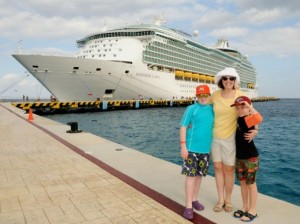Cruise Vacations Are Better Than Ever For The Physically Challenged
Most of the newer ships offer wheelchair assessable state rooms and can provide dining room seating arrangements to avoid stairs and raised areas. Just be sure your travel agent notifies the cruise line of your wheelchair usage and any other special needs prior to sailing when making your cruise vacation reservations. Cruise travelers with physical challenges should check with the onboard tour office to ensure that all pre-reserve tours can accommodate their needs.
 Cruise travel may be the ideal vacation for an individual using a wheelchair, since it provides the opportunity to visit a number of destinations in a relatively short time. A cruise vacation provides effortless travel between locations without the inconvenience of packing and unpacking. You’ll appreciate the choice of experiencing the ship’s destinations or relaxing and enjoying the comfort of being pampered at a “resort at sea.”
Cruise travel may be the ideal vacation for an individual using a wheelchair, since it provides the opportunity to visit a number of destinations in a relatively short time. A cruise vacation provides effortless travel between locations without the inconvenience of packing and unpacking. You’ll appreciate the choice of experiencing the ship’s destinations or relaxing and enjoying the comfort of being pampered at a “resort at sea.”
Is important that if one of your party uses a wheelchair you want to ask the following questions:
- How many wheelchair accessible cabins on the cruise ship?
- Are the doors to the rooms and elevators wide enough to accommodate a regular wheelchair?
- Can I get my wheelchair out on deck and into the public rooms during my cruise vacation?
- Will I be able to access the dining areas?
In some ports of call, where the ship must anchor, access via wheelchair may not be possible.
Ships generally stock a limited number of wheelchairs but please be aware they must be pre-reserved at the time of your booking.
Due to S.O.L.A.S. (Safety of Live At Sea) Regulations, physically challenged passengers must have partial mobility, and a traveling companion who can assist them, should an emergency arise.
You’ll find that the newer, larger cruise ships have been built with the goal of full-accessibility. A new ship will have wider corridors, more spacious cabins, more, and larger, elevators and ramps where needed. In addition, the designated “accessible” cabins on newer ships are outfitted with many of the following features that will make your cruise vacation a more comfortable experience:
- Stateroom and cabin doorways wide enough for wheelchairs (at least 30″)
- Stateroom dimensions and floor space for maneuverability and bathroom dimensions adequate for maneuvering
- No “lips” or sills into bathrooms
- Sink positioned so wheelchair can roll under it
- Roll-in shower wit a fold-down stool in shower with detachable showerhead
- Bathroom walls with handrails
- Raised toilet seat, at least 17″ inches high
- Pull-down clothing racks
- Light switches at wheelchair level
- Adjustable mirror above sink
- Portable telephone
- Blinking lights in staterooms for the hearing challenged
In some ports, ships must anchor offshore due to size of the port or because of extreme weather (if the weather is too extreme they won’t stop at that port at all). They “tender” guests to shore with small boats that may not be accessible to guests in wheelchairs. You’ll want to check with the shore excursions department to determine which shore excursions are most suitable for you. In some destinations, particularly those outside of the United States, you will not always find accessible transportation and facilities.
Some of the Princess cruise line ships have hoists by the pool so a physically challenged passengers can enjoy the pool. Some of Holland American ships have the ability to tender wheelchairs into ports where they do not dock. Ask your travel agent to inquire with those lines to find the ship that is suitable for you.
There is no reason that anyone who is physically challenged should avoid a cruise vacation. Just remember when you are looking into cruise travel that you have your travel agent find the cruise ship that caters to your needs.
Now that you know that a cruise vacation may be perfect for you, call your travel agent and start packing.
Happy Cruising!










